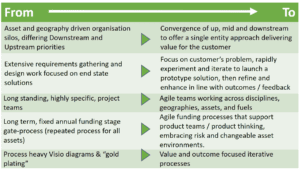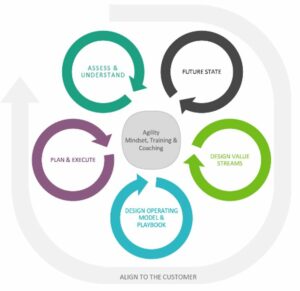
If you have been following our energy transition series thus far, we have focused on the totemic changes across national policy makers and global energy producers. Organisations are seeking to not only change the work they do and the products they sell, but also transform how they work.
The energy organisation of the future needs to become more Agile to enable the transition.
It is becoming increasingly clear the traditional command-and-control, departmental or asset led, energy company will not best support the shift required for the energy transition. Many organisations have started on this journey, seeing “Agile”, and increased “business agility”, as the best approach to develop the “organisational muscle” and nimbleness needed.
Energy organisations are learning from digital and technology companies who, unburdened by legacy, can deliver value, at speed and quality, to their customers. They have looked to replicate certain lessons by pivoting their organisations towards a cross-department collaboration model, focused on delivering customer value, not just processes, within a culture of innovation and empowerment.
Some organisations are well down this transformation journey and rapidly shifting how they work. Others are just at the start. Wherever you are in your journey, there are lessons to be learnt and potential course-corrections to take.
Why should you adopt Agile ways of working?
Agile, increasingly a buzzword but often misunderstood, has been shown to have spectacular results. In fact, research has shown that a shift to Agile can lead to:
* 35% increase in productivity
* 30% happier, more motivated employees
* 50% faster Time-to-Market
* 50% defect reduction
What this might look like on the ground in an energy super major:

Our Agile development philosophy:

Our philosophy is built upon five key cycles of value, aligned at all times to the customer.
Each cycle has clear, deliverable outcomes, with the flexibility to focus on the cycles that add maximum value.
The middle of the model highlights the importance of agility mindset training and coaching, underpinning each stage of the journey.
For Agile transformation to be successful, you also must:
* Think of the customer first – all activities and recommendations working back from the customer
* Test, learn and iterate using pilots
* Demonstrate early wins and tangible value whilst building advocacy for Agile ways of working
* Develop simple frameworks / playbooks to support enterprise consistency and transparency
* An enterprise working mindset – foster cross functional engagement and problem solving
* Learn to ‘lead Agile’ – sponsors and decision approvers understand they are investing in the team to solve the problem, rather than investing in a specific solution.
A note of caution to those currently undergoing Agile transformation or seeking to start:
Agile change is not linear, there is no big bang deployment, and it must be iterative in nature. Think three to five years, not 6 months.
Too often senior leaders accelerate the Agile agenda without taking the time to understand, ‘what does this mean for us?’ or ‘is it really suitable?’. Resultingly, many organisations, to their later pain, seek to implement frameworks without considered analysis and insights.
Whether reassessing your journey, or just starting out, keep these considerations at front of mind:
If you want to find out more about how Agile can help drive the future shape and way of operating within your organisation, then feel free to get in touch.
Jamie Scott – Head of Energy, Q5
